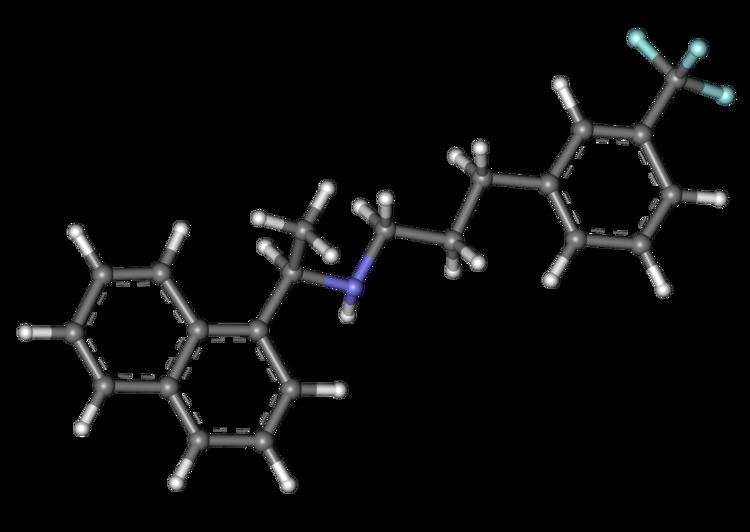Trade names Sensipar, Mimpara MedlinePlus a605004 Molar mass 357.412 g/mol | AHFS/Drugs.com Monograph Routes ofadministration By mouth CAS ID 226256-56-0 | |
 | ||
License data EU EMA: MimparaUS FDA: Cinacalcet Pregnancycategory AU: B3US: C (Risk not ruled out) | ||
Cinacalcet (INN) is a drug that acts as a calcimimetic (i.e. it mimics the action of calcium on tissues) by allosteric activation of the calcium-sensing receptor that is expressed in various human organ tissues (Van Wagenen et al. (2001), U.S. Pat. 6,211,244). It is sold by Amgen under the trade name Sensipar in North America and Australia and as Mimpara in Europe. Cinacalcet is used to treat secondary hyperparathyroidism (elevated parathyroid hormone levels), a consequence of end-stage renal disease. Cinacalcet is also indicated for the treatment of hypercalcemia in patients with parathyroid carcinoma. Cinacalcet was FDA approved in March 2004, and was the first allosteric G protein-coupled receptor modulator to enter the pharmaceutical market. In 2014, cinacalcet was 76th out of the top 100 drugs in the list of largest selling pharmaceutical products.
Contents
Medical uses
Cinacalcet is indicated for the treatment of tertiary hyperparathyroidism in people with chronic kidney disease on dialysis and hypercalcemia in people with parathyroid carcinoma. Cinacalcet can also be used to treat severe hypercalcemia in patients with primary hyperparathyroidism who are unable to undergo parathyroidectomy.
In the treatment of tertiary hyperparathyroidism due to chronic kidney disease on dialysis it does not appear to affect mortality. It does decrease the need for a parathyroidectomy but caused more issues with low blood calcium levels.
Pregnancy and lactation
Cinacalcet has pregnancy category C in the US, meaning that adequate and well-controlled studies involving cinacalcet in pregnant women have not been done.
Studies have not been done in lactating women; therefore it is not known whether cinacalcet is excreted into human milk.
Contraindications
Hypocalcemia (decreased calcium levels) is a contraindication of cinacalcet. Patients who have serum calcium levels less than 7.5 mg/dL should not be started on cinacalcet. Hypocalcemia symptoms include parathesias, myalgias, muscle cramping, tetany, and convulsions. Cinacalcet should not be administered until serum calcium levels are above 8.0 mg/dL and/or hypocalcemia symptoms are resolved.
Adverse effects
Common side effects of cinacalcet include stomach upset, vomiting, diarrhea, dizziness, nausea, weakness, and chest pain.
Clinical trials conducted in the United States by Amgen to determine whether the drug is safe in children were halted by the FDA in February 2013 following the death of a 14-year-old patient.
Overdose
Serious side effects, including overdose symptoms, of cinacalcet include:
Interactions
Cinacalcet is a strong inhibitor of the liver enzyme CYP2D6 and is partially metabolized by CYP3A4 and CYP1A2. Dose adjustments may be necessary if patients are treated with CYP3A4 and CYP1A2 inhibitors and medications that are metabolized by CYP2D6.
Mechanism of action
Cinacalcet is a drug that acts as a calcimimetic (i.e. it mimics the action of calcium on tissues) by allosteric activation of the calcium-sensing receptor that is expressed in various human organ tissues. The calcium-sensing receptors on the surface of the chief cell of the parathyroid gland is the principal regulator of parathyroid hormone secretion. Cinacalcet increases the sensitivity of calcium receptors on parathyroid cells to reduce parathyroid hormone (PTH) levels and thus decrease serum calcium levels. As receptors are already active from the calcimimetic (cinacalcet) the native rise and fall of calcium levels now interact with the remaining receptors, effectively lowering the threshold for activation of feedback on the parathyroid chief cells.
The intravenously administered drug etelcalcetide has the same mechanism of action.
